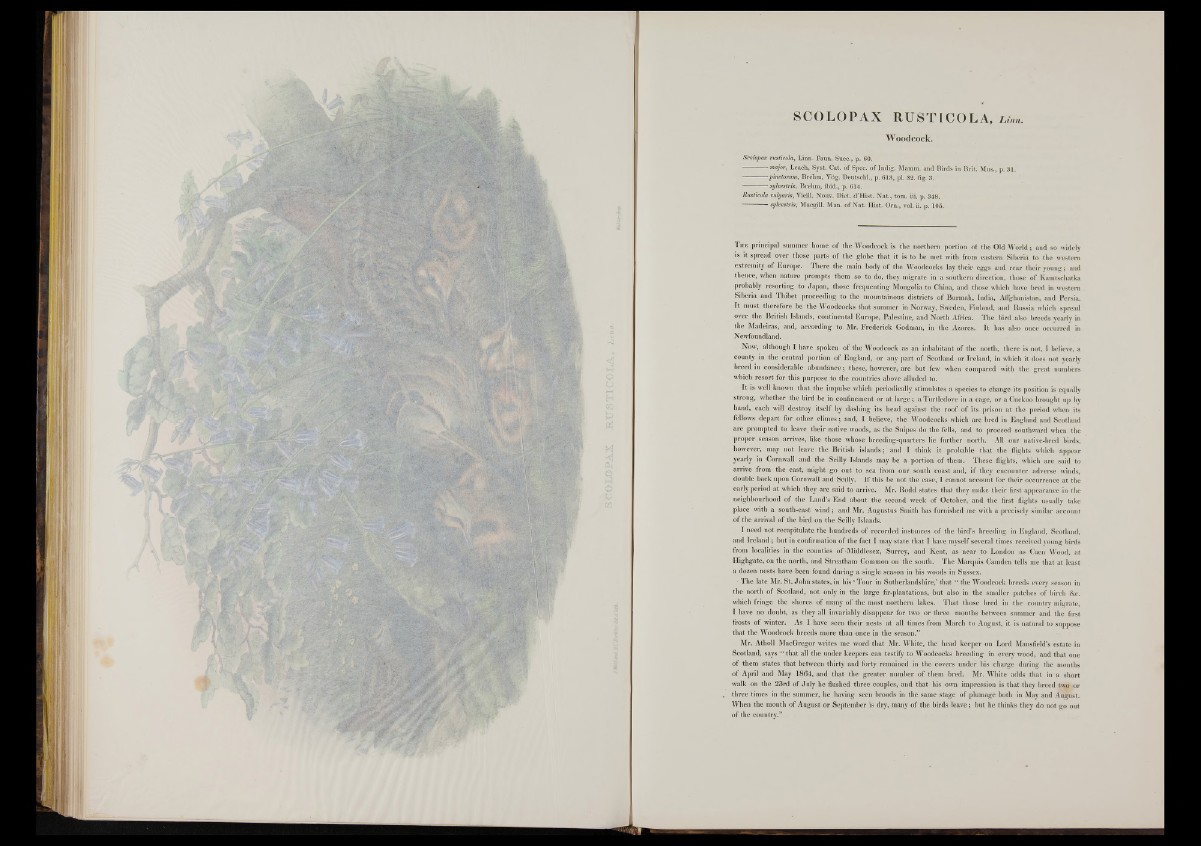
SCOLOPAX RUSTICOLA, Linn.
Woodcock.
Scolopax rusticóla, Linn. Faun. Suec., p. 60.
-----------major, Leach, Syst. Cat. of Spec, of Indig. Mamm. and Birds in Brit. Mus., p. 31.
— pinetomm, Brehm, Vög. Deutschl., p. 613, pi. 32. fig. 3.
----------- sylvestris, Brehm, ibid., p. 614.
Rusticóla vulgaris, Viejll. Nouv. Diet. d’Hist. Nat., tom. iii. p. 348.
—-------- sylvestris, Macgill. Man. of Nat. Hist. Orn., vol. ii. p. 105.
T h e .principal summer home o f the Woodcock is the northern portion of the Old W o rld ; and so widely
is it spread over those parts o f the globe that it is to be met with from eastern Siberia to the western
extremity of Europe. There the main body o f the Woodcocks lay their eggs and rear their young; and
thence, when nature prompts them so to do, they migrate in a southern direction, those of Kamtschatka
probably resorting to Japan, those frequenting Mongolia to China, and those which have bred in western
Siberia and Thibet proceeding to the mountainous districts o f Burmah, India, Affghanistan, and Persia.
I t must therefore be, the Woodcocks th at summer in Norway, Sweden, Finland, and Russia which spread
over the British Islands, continental Europe, Palestine, and North Africa. The bird also breeds yearly in
the Madeiras, and, according to. Mr. Frederick Godman, in the Azores. It has also once occurred in
Newfoundland.
Now, although I have spoken o f the Woodcock as an inhabitant o f the north, there is not, I believe, a
county in the central portion o f England, o r any p art of Scotland or Ireland, in which it does not yearly
breed in considerable abundance; these, however, are but few when compared with the great numbers
which resort for this purpose to the countries above alluded to.
I t is well known that the impulse which periodically stimulates a species to change its position is equally
strong, whether the bird be in confinement or at large ; a Turtledove in a cage, or a Cuckoo brought up by
hand, each will destroy itself by dashing its head against the roof of its prison at the period when its
fellows depart for other climes; and, I believe, the Woodcocks which are bred in England and Scotland
are prompted to leave their native woods, as the Snipes do the fells, and to proceed southward when the
proper season arrives, like those whose breeding-quarters lie further north. All our native-bred birds,
however, may not leave the British islands; and I think it probable that the flights which appear
yearly in Cornwall and the Scilly Islands may be a portion of them. These flights, which are said to
arrive from the east, might go out to sea from our south coast and, if they encounter adverse winds,
double back upon Cornwall and Scilly. I f this be not the case, I cannot account for their occurrence at the
early period a t which they are said to arrive. Mr. Rodd states that they make their first appearance in the
neighbourhood o f the Land’s End about the second week of October, and the first flights usually take
place with a south-east wind; and Mr. Augustus Smith has furnished me with a precisely similar account
o f the arrival o f the bird on the Scilly Islands.
I need not recapitulate the hundreds o f recorded instances o f the bird’s breeding in England, Scotland,
and Irelan d ; but in confirmation o f the fact I may state that I have myself several times received young birds
from localities in the counties of-Middlesex, Surrey, and Kent, as near to London as Caen Wood, at
Highgate, on the north, and Streatham Common on the south. The Marquis Camden tells me that a t least
a dozen nests have been found during a single season in his woods in Sussex.
• The late Mr. St. John states, in his ‘ Tour in Sutherlandshire,’ that “ the Woodcock breeds every season in
the north o f Scotland, not only in the large fir-plantations, but also in the smaller patches of birch &c.
which fringe the shores o f many o f the most northern lakes. That those bred in the country migrate,
I have no doubt, as they all invariably disappear for two or three months between summer and the first
frosts o f winter. As I have seen their nests at all times from March to August, it is natural to suppose
that the Woodcock breeds more than once in the season.”
Mr. Atholl MacGregor writes me word th at Mr. White, the head keeper on Lord Mansfield’s estate in
Scotland, says “ that all the under keepers can testify to Woodcocks breeding in every wood, and that one
o f them states that between thirty and forty remained in the covers under his charge during the months
o f April and May 1864, and that the greater number o f them bred. Mr. White adds th at in a short
walk on the 23rd o f July he flushed three couples, and th at his own impression is that they breed two or
three times in the summer, he having seen broods in the same stage o f plumage both in May and August.
When the month o f August or September is dry, many o f the birds leave; but he thinks they do not go out
of the country.”.